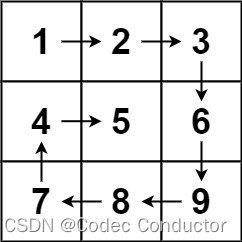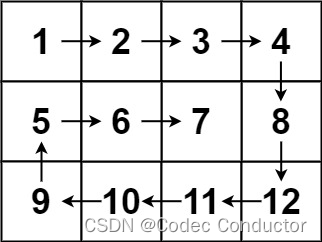原题链接🔗 :螺旋矩阵
难度:中等⭐️⭐️
题目
给你一个 m 行 n 列的矩阵 matrix ,请按照 顺时针螺旋顺序 ,返回矩阵中的所有元素。
示例 1 :

输入:matrix = [[1,2,3],[4,5,6],[7,8,9]]
输出:[1,2,3,6,9,8,7,4,5]
示例 2 :

输入:matrix = [[1,2,3,4],[5,6,7,8],[9,10,11,12]]
输出:[1,2,3,4,8,12,11,10,9,5,6,7]
提示 :
m == matrix.length
n == matrix[i].length
1 <= m, n <= 10
-100 <= matrix[i][j] <= 1
题解
四指针遍历法
- 题解:
这个算法不需要修改原始矩阵。以下是实现这个算法的步骤:
- 初始化四个边界:
top表示矩阵的顶部边界,bottom表示底部边界,left表示左侧边界,right表示右侧边界。- 创建一个空列表
result用于存储按螺旋顺序排列的元素。- 使用一个循环,直到
top大于bottom或left大于right:
- 从
left到right遍历top行,将这些元素添加到result。- 增加
top的值,缩小顶部边界。- 从
top到bottom遍历right列,将这些元素添加到result。- 减少
right的值,缩小右侧边界。- 如果
top小于等于bottom,从right到left遍历bottom行,将这些元素添加到result。- 减少
bottom的值,缩小底部边界。- 如果
left小于等于right,从bottom到top遍历left列,将这些元素添加到result。- 增加
left的值,缩小左侧边界。- 返回
result列表,它包含了矩阵中所有元素的顺时针螺旋顺序。
- 复杂度:时间复杂度O(m×n),因为每个单元格都被填充一次;空间复杂度O(m×n),用于存储最终的矩阵。
- 过程:
螺旋矩阵是一种特殊的矩阵,其元素按照螺旋的方式填充,从外圈向内圈逐渐填充,每个元素的值依次递增。
实现过程如下:
首先,函数检查输入矩阵是否为空或其子数组是否为空。如果是,则直接返回一个空的一维数组。
定义四个变量
top,bottom,left,right来分别表示矩阵的上边界、下边界、左边界和右边界。使用一个
while循环,当top不大于bottom且left不大于right时,循环继续。这确保了矩阵中至少还有一行或一列可以遍历。在循环内部,首先从
left到right遍历矩阵的顶部行,将这些元素添加到结果数组中,然后top加1。接着,从
top到bottom遍历矩阵的最右列,将这些元素添加到结果数组中,然后right减1。确保在继续之前,当前的遍历行与上一次的遍历行不同(如果
top小于等于bottom),从right到left遍历矩阵的底部行,然后bottom减1。同样,确保在继续之前,当前的遍历列与上一次的遍历列不同(如果
left小于等于right),从bottom到top遍历矩阵的最左列,然后left加1。函数最后返回包含矩阵所有元素的一维数组,这些元素按照螺旋顺序排列。
main函数中创建了3x3、3x4的两个矩阵,并调用spiralOrder函数来获取螺旋顺序的元素,然后打印这些元素。
- c++ demo:
cpp
#include <iostream>
#include <vector>
std::vector<int> spiralOrder(const std::vector<std::vector<int>>& matrix) {
if (matrix.empty() || matrix[0].empty()) return {};
std::vector<int> result;
int top = 0, bottom = matrix.size() - 1;
int left = 0, right = matrix[0].size() - 1;
while (top <= bottom && left <= right) {
// Traverse from left to right.
for (int i = left; i <= right; ++i) {
result.push_back(matrix[top][i]);
}
++top;
// Traverse downwards.
for (int i = top; i <= bottom; ++i) {
result.push_back(matrix[i][right]);
}
--right;
// Make sure we are now on a different row.
if (top <= bottom) {
for (int i = right; i >= left; --i) {
result.push_back(matrix[bottom][i]);
}
--bottom;
}
// Make sure we are now on a different column.
if (left <= right) {
for (int i = bottom; i >= top; --i) {
result.push_back(matrix[i][left]);
}
++left;
}
}
return result;
}
int main() {
std::vector<std::vector<int>> matrix = {
{1, 2, 3},
{4, 5, 6},
{7, 8, 9}
};
std::vector<int> spiral = spiralOrder(matrix);
for (int num : spiral) {
std::cout << num << " ";
}
std::cout << std::endl;
std::vector<std::vector<int>> matrix2 = {
{1, 2, 3, 4 },
{5, 6, 7, 8 },
{9, 10, 11, 12}
};
std::vector<int> spiral2 = spiralOrder(matrix2);
for (int num : spiral2) {
std::cout << num << " ";
}
std::cout << std::endl;
return 0;
}- 输出结果:
1 2 3 6 9 8 7 4 5
1 2 3 4 8 12 11 10 9 5 6 7
